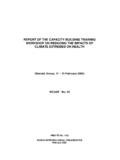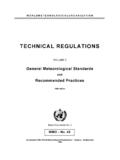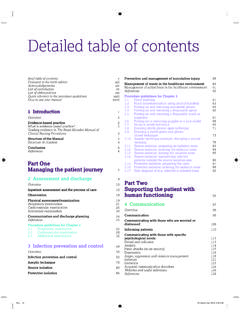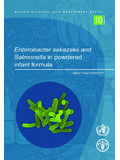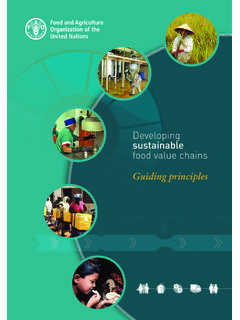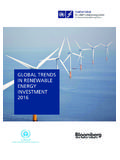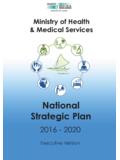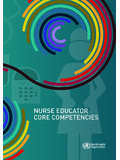Transcription of Planning of water quality monitoring systems - …
1 Planning Of water quality monitoring systeMsteCHniCAlRePORt seRiesno. 3 WMO-No. 1113 Planning OF water -QUALITYMONITORING SYSTEMSTEchNIcAL REPORT SERIES No. 3 WMO-No. 1113 WMO-No. 1113 World Meteorological Organization, 2013 The right of publication in print, electronic and any other form and in any language is reserved by WMO. Short extracts from WMO publications may be reproduced without authorization, provided that the complete source is clearly indicated. Editorial correspondence and requests to publish, reproduce or translate this publication in part or in whole should be addressed to:Chair, Publications BoardWorld Meteorological Organization (WMO)7 bis, avenue de la Paix Tel.: +41 (0) 22 730 84 03PO Box 2300 Fax: +41 (0) 22 730 80 40CH-1211 Geneva 2, Switzerland E-mail.
2 978-92-63-11113-5 NOTEThe designations employed in WMO publications and the presentation of material in this publication do not imply the expression of any opinion whatsoever on the part of WMO concerning the legal status of any country, territory, city or area, or of its authorities, or concerning the delimitation of its frontiers or mention of specific companies or products does not imply that they are endorsed or recommended by WMO in preference to others of a similar nature which are not mentioned or findings, interpretations and conclusions expressed in WMO publications with named authors are those of the authors alone and do not necessarily reflect those of WMO or its Effects of natural phenomena on water quality .. Anthropogenic pressures.
3 Point loading and non-point loading .. Spatial and temporal variations .. Variability of water quality .. Main purposes of a WQM programme .. monitoring for management .. Hydrological monitoring .. Types of WQM programmes .. Early warning systems .. Establishment of objectives of the monitoring programme .. water - quality monitoring information needs .. Legislation and administrative setting .. Planning a monitoring network .. Selection of sampling stations .. Preliminary surveys .. Documentation .. Classification of WQ variables .. Selection of variables .. Hydrological variables .. Methods for field monitoring .. Frequency of sampling .. Time of sampling .. Laboratory facilities .. Inventory of field stations, monitoring wells, equipment and instruments.
4 Transport .. Staffing .. Human-resources development and training .. Communication .. Estimation of costs of the programme .. 42 Planning of water - quality monitoring Components of quality assurance .. Laboratory facilities .. Equipment maintenance, calibration and quality -control of fieldwork .. Analytical quality -control .. quality assurance of data .. WQ standards and indices .. Data handling and management .. Data analysis and dissemination .. Reporting .. International frameworks .. Global databases .. Related guidance material .. 1 Categories and principal characteristics of water - quality monitoring operations .. 62 Table 2 GEMS/ water variables .. 63 Table 3 DPSIR framework for water quality of surface- and groundwater ecosystems 64 Table 4 Selection of variables for assessment of water quality in relation to non-industrial water uses.
5 65 Table 5 Selection of variables for the assessment of water quality in relation to some key industrial uses .. 67 Table 6 Selection of variables for the assessment of water quality in relation to non-industrial pollution sources .. 69 Table 7 Selection of variables for the assessment of water quality in relation to some common industrial sources of pollution .. 71 Table 8 Recommended annual sampling frequencies for GEMS/ water stations .. 73 Table 9 Examples of responsibilities of staff on a water - quality monitoring programme .. 74 Table 10 Management documents needed (ISO/IEC 17025, 2005) to implement the quality assurance programme ( quality manual).
6 General variables .. 76 2. Nutrients .. 803. Organic matter .. 814. Major ions .. 825. Other inorganic variables .. 826. Metals .. 837. Organic contaminants .. 848. Biological variables .. 859. Microbiological indicators .. 8710. Sedimentation .. WQ monitoring equipment .. 892. Optical monitoring .. 893. Simple field-measured variables .. 904. Other important parameters that can be measured in situ .. 91 ContentsvPage5. Traditional water -sampling for laboratory chemical and biological analysis .. 936. Special sampling procedures .. 957. Biological assessment and fish tests .. 968. Kits .. 979. Remote-sensing (satellite, airborne or ground-based) .. 9810. Advanced instrumental analysis .. 10011. Sampling procedures for isotopes in hydrological investigations.
7 101 AppendicesAppendix 1. Summary of water - quality guidelines and standards by international organization or country .. 103 Appendix 2 Key features of each chemical and physicochemical quality element (QE) for lakes .. 105 Appendix 3. Key features of each biological quality element (QE) for lakes .. 1. Structure of water - quality monitoring operations .. 14 BoxesBox 1 Characteristics of spatial and temporal variations in water - quality .. 6 Box 2 Examples of the relationships between uses or functions and issues in a river basin .. 10 Box 3 Typical monitoring objectives .. 17 Box 4 Categories of water - quality parameters .. 25 Box 5 Methods for field monitoring .. 30 Box 6 Selected environmental variables that can be monitored automatically .. 33 Box 7 Biological, chemical and in situ water - quality monitoring : advantages and.
8 Shortcomings .. 34 Box 8 Main water - quality programme cost components .. 43 Box 9 Priorities to meet future needs for water - quality monitoring and assessment .. 60 ForewordOne of the United Nations Millennium Development Goals is to improve access to safe water , which is an engine for socio-economic growth. In this context, the importance of water - resources information systems cannot be overestimated in the socio-economic development process of nations and the world Meteorological Organization (WMO) Bulletin 61(1) (2012) states that the timing and spatial distribution of surface water quantity and the variability in quality of that water define how we design and build the infrastructure necessary for our energy, agriculture, mining, transportation and industrial sectors.
9 Safe drinking- water sources and entire ecosystems depend on continuous improvements of our understanding of, and efforts to protect, our water resources. One of the main messages from the Fifth Global Environment Outlook (GEO-5, 2012) of the United Nations Environment Programme (UNEP) is that addressing the most challenging water -resources issues facing society can be solved equitably and efficiently with an integrated management approach directed to the sustainable use of water . In order to achieve this, it is essential that effective water - monitoring programmes, together with sound data and information management, are operational globally. Unfortunately, in many places in the world, such systems are not in place. This Technical Report: Planning of water quality monitoring systems , has been developed by WMO jointly with UNEP GEMS/ water in an effort to provide basic know-how and the materials needed to plan, establish and operate water - quality monitoring systems on national levels but also with a view to improving access to water - quality data and information in transboundary basins and is largely intended for use by water -agency managers whose dominant technical background is in hydrology, meteorology, engineering or water -resources management, rather than water quality , but who are responsible for the effective monitoring of developments and trends in the state of inland waters.
10 There is an extensive literature on the setting-up and operation of water - monitoring programmes, so this Technical Report should be viewed as a primer or basic tool to be used in conjunction with other more detailed handbooks and academic literature. It is hoped that national water managers and planners, as well as the international water community, will find this report a useful tool that will lead to improved water - quality networks in conjunction with hydrometric stations that will enhance water - quality monitoring systems and a better assessment of the variability of water resources in terms of both quality and quantity. The Technical Report has been prepared as a team effort, involving a number of experts from various fields of water - quality monitoring and management.







